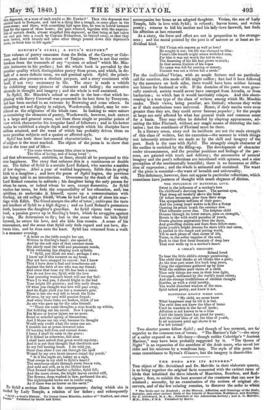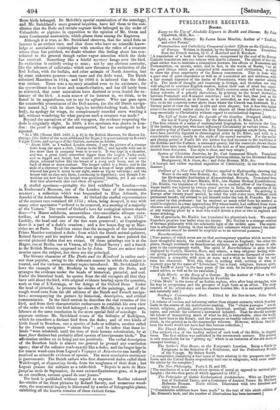THE DODO AND ITS KINDRED. *
Tim object of Mr. Strickland and Dr. Melville in their elaborate quarto, is to bring together the original facts connected with the extinct races of birds that inhabited the three islands of Mauritius, Bourbon, and Rod- riguez first, to exhibit the best account of the creatures that can now be attained ; secondly, by an examination of the notices of original ob- servers, and of the few existing remains, to discover the order to which
• The Dodo and its Kindred; or the History. Affinities, and Osteology of the Dodo. Solitaire, and other extinct Birds of the Islands of Mauritius, Rodriguez, and Bourbon.. By E. Strickland, M.A., Sic., President of the dithmolean Society ; and A. G. Melville, M.D., Edln., F.R.S. Published by Reeve.
those birds belonged. Dr. Mdville's special examination of the osteology, and Mr. Strickland's more general inquiries, have led them to the eon- elusion that the Dodo and certain cognate birds belonged to the order of Columbidm or pigeons, in opposition to the opinion of Mr. Owen and some Continental anatomists, which places them among the Raptores.
Although it is true, as Mr. Strickland observes, that the mind feels an interest in an extinct race, and that those who have no scientific know- ledge or associations contemplate with emotion the relics of a creature whose class has perished, we doubt whether this feeling alone has con- tributed to the general though rather vague attention which the dodo has received. Something like a fateful mystery hangs over the bird. Its extinction is entirely owing to man ; not by any obvious necessity, like the advance of cultivatioa which now threatens the extinction of the Red Indian with the buffalo, and other animals of North America, but by some unknown process—man came and the dodo went. The Dutch colonized Mauritius in 1644, and by 1693 it is inferred that the dodo was extinct. There was a mystery attached even to its existence ; for the eye-evidence is so loose and nuauthoritative, and has till lately been so scattered, that some naturalists have doubted or even denied the ex- istence of the bird. A main source of its interest is, we think, to be found in its ungainliness, not to say its ugliness. Who can gaze upon the counterfeit presentment of the Dod-aarsen, (as the old Dutch naviga- tors named it,) with its short legs, its terrible-looking beak, its bulky body, its apology for wings, its conspicuously rounded stern wanting a tail, without wondering for what purpose such a creature was made?
Beyond the narratives of the old voyagers, the evidence respecting the dodo is singularly slight. In 1638, a live specimen was shown in Lon- don: the proof is singular and unsupported, but too undesigned to be rejected.
"In a MS. (Sloane MSS. 1839, 5, p. 9) in the British Museum, Sir Hamon La. strange, (the father of the more celebrated Sir Roger,) in a commentary on Brown's Vulgar Errors, and apropos of the Ostrich, narrates as follows.
About 1638, as I walked London streets, I saw the picture of a strange fowle hong out upon a cloth, [hiatus in the MS.,] and myselfe with one or two more then in company went in to see it. It was kept in a chamber, and was a great fowle somewhat bigger than the largest Turky cock, and so legged and footed, but stouter and thicker and of a more erect shape, coloured before like the breast of a yong cock fesan, and on the back of dunn or deare contour. The keeper called it a Dodo; and in the ende of a chymney in the chamber there lay a heap of large pebble stones, whereof has gave it many in our sight, some as big-as nutmegs; and the keeper told us shee eats them, (conducing to digestkm); and though I re- member not how farr the keeper was questioned thqem, yet I am confi-, dent that afterwards shoe cast them all againe:" A stuffed specimen—probably the bird exhibitedln London—was in Tredescant's Museum, one of the London lions of the seventeenth century; a collection 'which was bequeathed to Elias Ashmole, the founder of the Ashmolean Museum. At Oxford the staffed representatiye of the extinct race remained till 175.5; when, being decayed, it was with many other specimens "ordered to be removed, at a meeting of a majority of the Visiters." The record of Oxford's love for zoological science stands thus—" a Masco subducta, annuentibus vice-cancellario aliisque curs- toribus, ad ea lustranda convocatis die Jannarii 8vo. A.D. 1755." Luckily, the head and one of the feet were preserved ; at Copenhagen there is a part of a dodo's cranium ; and a few bones dug up at Mau- ritius are at Paris. Tradition states that the menagerie of the celebrated Prince Maurice contained a dodo ; from which the Dutch animal-painters, Roland Savery and his nephew John, are supposed to have painted the several pictured dodos that are extant. Of these paintings one is at the Hague, one at Berlin, one at Vienna, all by Roland Savery ; and a fourth in the British Museum, supposed to be by John. There are minor testi- monies upon the subject, but these are the principal. The literary character of The Dodo and its Kindred is rather curi- ous thaw popular, owing to the elaborate manner in which the subject is treated, and the various secondary topics introduced. Mr. Strickland fol- lows the example of Mr. Broderip in his essay upon the Dodo, and arranges the evidence under the heads of historical, pictorial, and real. Under the historical head, he quotes from the old voyagers all that they have said about the bird, with original evidence bearing upon the question, such as that of L'Estrange, or the doings of the Oxford Dons. Under the head of pictorial, be presents the-similes of the paintings, and of the rough wood-cuts from the old editions of the Dutch and French naviga- tors; accompanying the picture by historical, descriptive, and critical commentaries. In the third section he describes the real remains of the bird, and from their characteristics endeavours to establish his own view of the order to which the bird belonged ; as Dr. Melville, in a second part, labours at the same conclusion in the more special field of osteology. In separate sections Mr. Strickland treats of the Solitaire of Rodriguez, which he considers a distinct bird from the dodo; and of two kinds of birds found in Bourbon, one a species of dodo or solitaire, another called by the French navigators " oisean bleu " : and he infers that these is- lands "were inhabited, until the time of their human colonization by at least four distinct but probably allied species of brevipennate birds." The affirmation strikes us as being put too positively. The verbal description of the Bourbon birds is almost too general to ground any conclusion upon; that of the solitaire reads exactly like a dodo; and the longer legs in the coarse wood-cuts from Leguat's Voyages et Avantures can hardly be received as scientific evidence of species. The most conclusive testimony is gastronomic. The Dutch sailors who first discovered dodos called them Walckvogel, or disgusting birds, from the toughness of their flesh ; but Leguat praises the solitaire as a table-bird. " Depuis le mois de Mars jusqu'au mois de Septembre, ils sont extraordinairement gras, et le goat en eat excellent, surtout quand us sont jeunes."
The book is published without regard to expense. Besides coloured he-similes of the three pictures by Roland Savery, and numerous wood- cuts, the anatomical inquiry is illustrated by a series of lithographic plates, exhibiting all the known remains of these extinct forms.



























 Previous page
Previous page